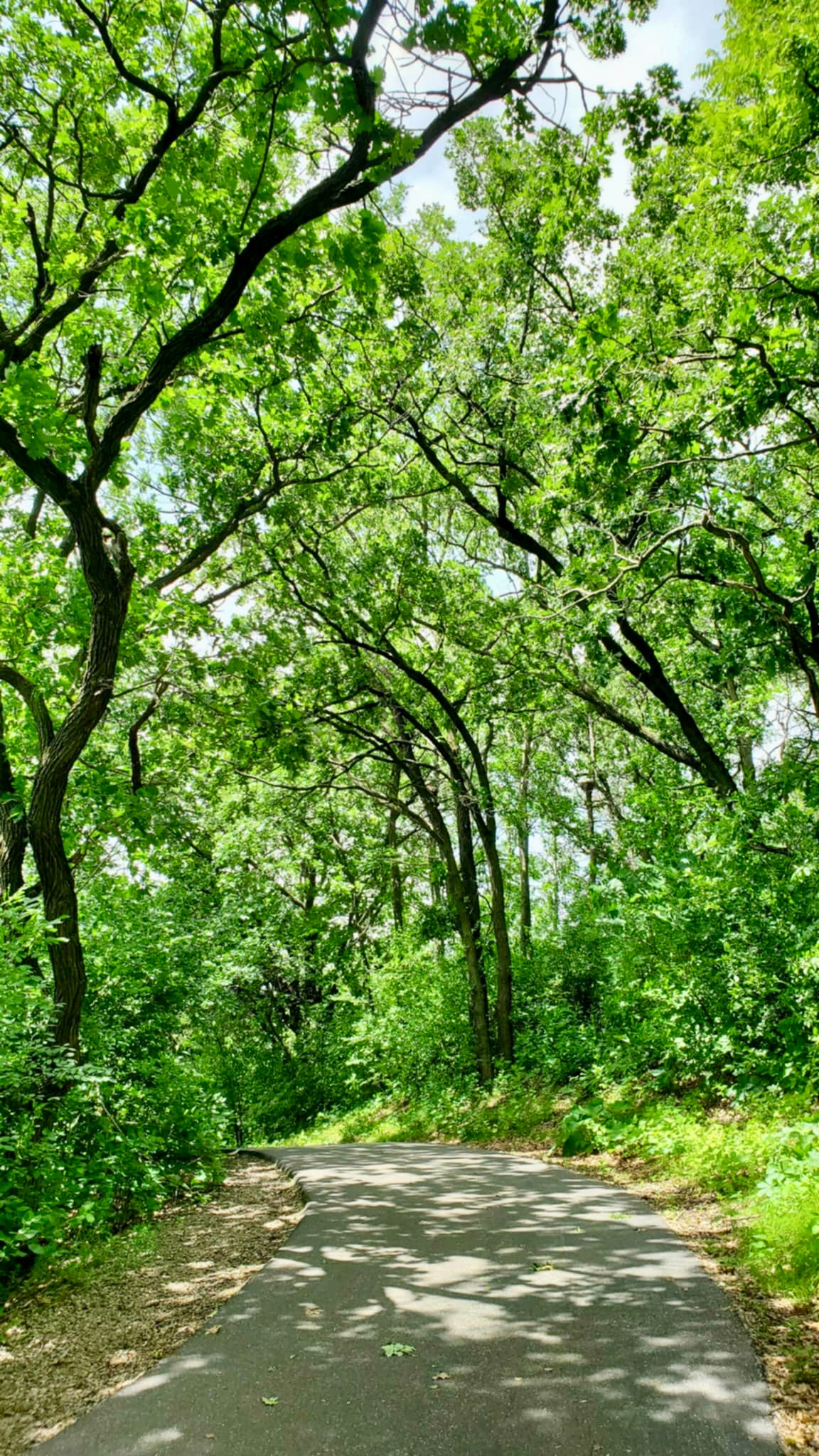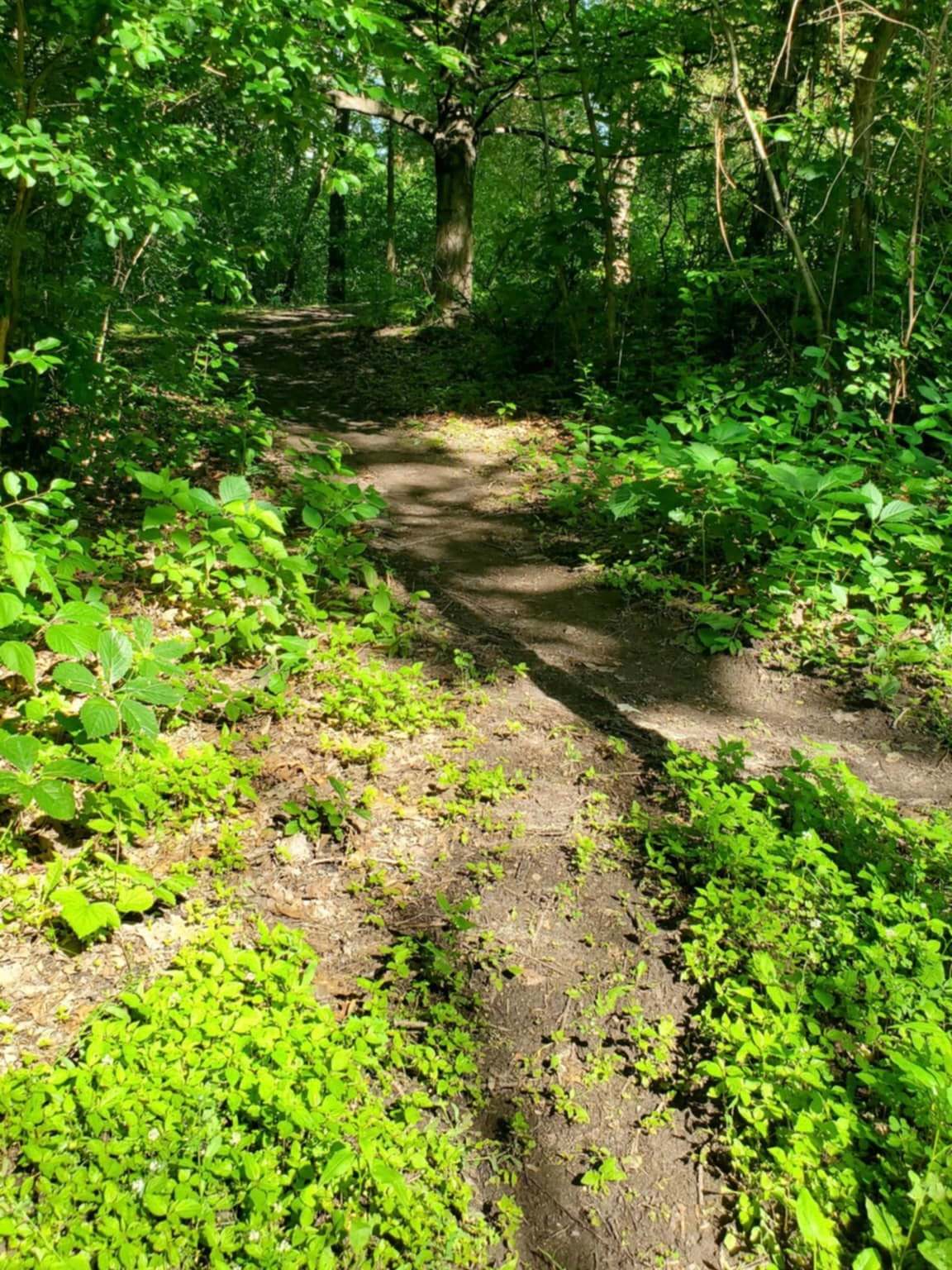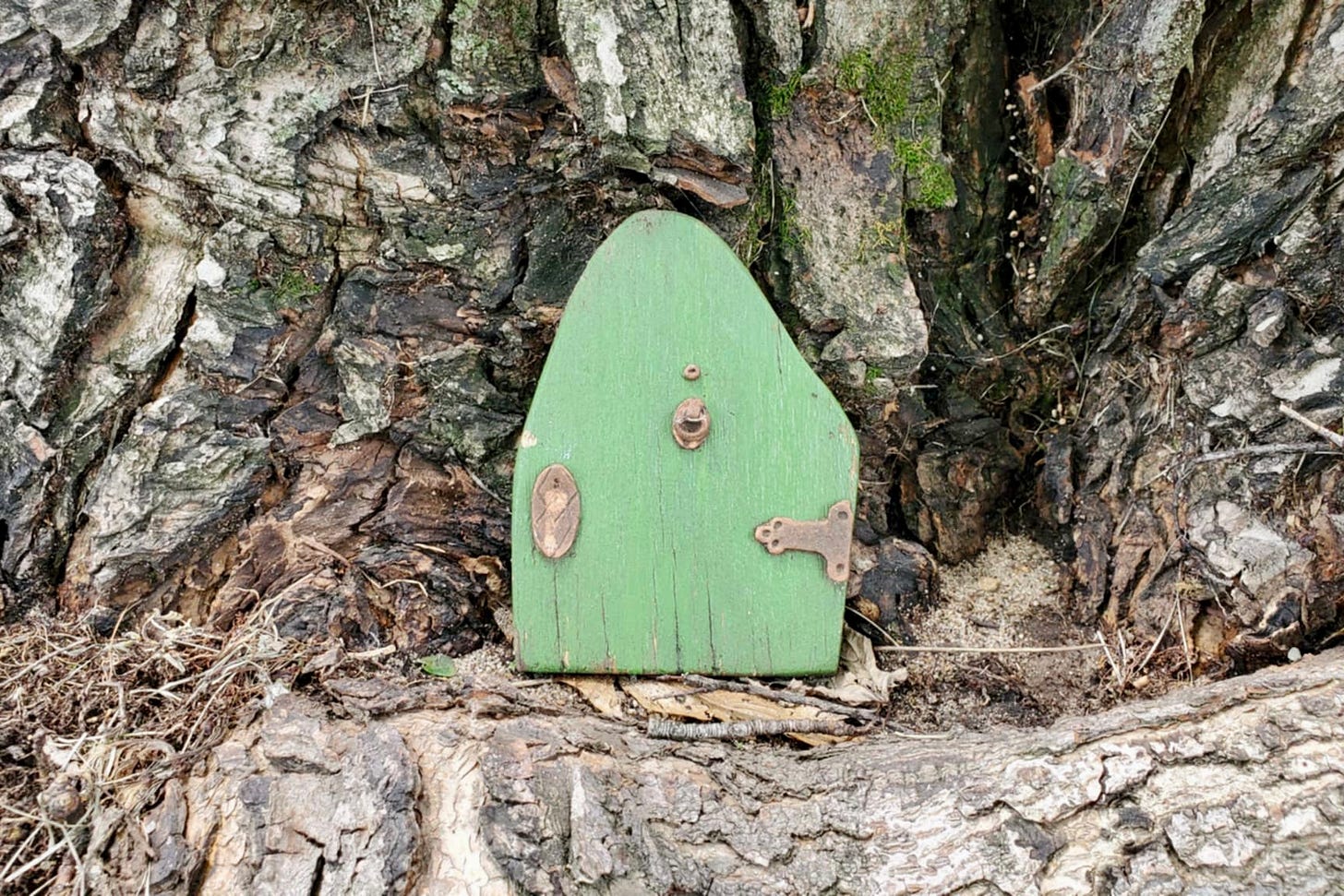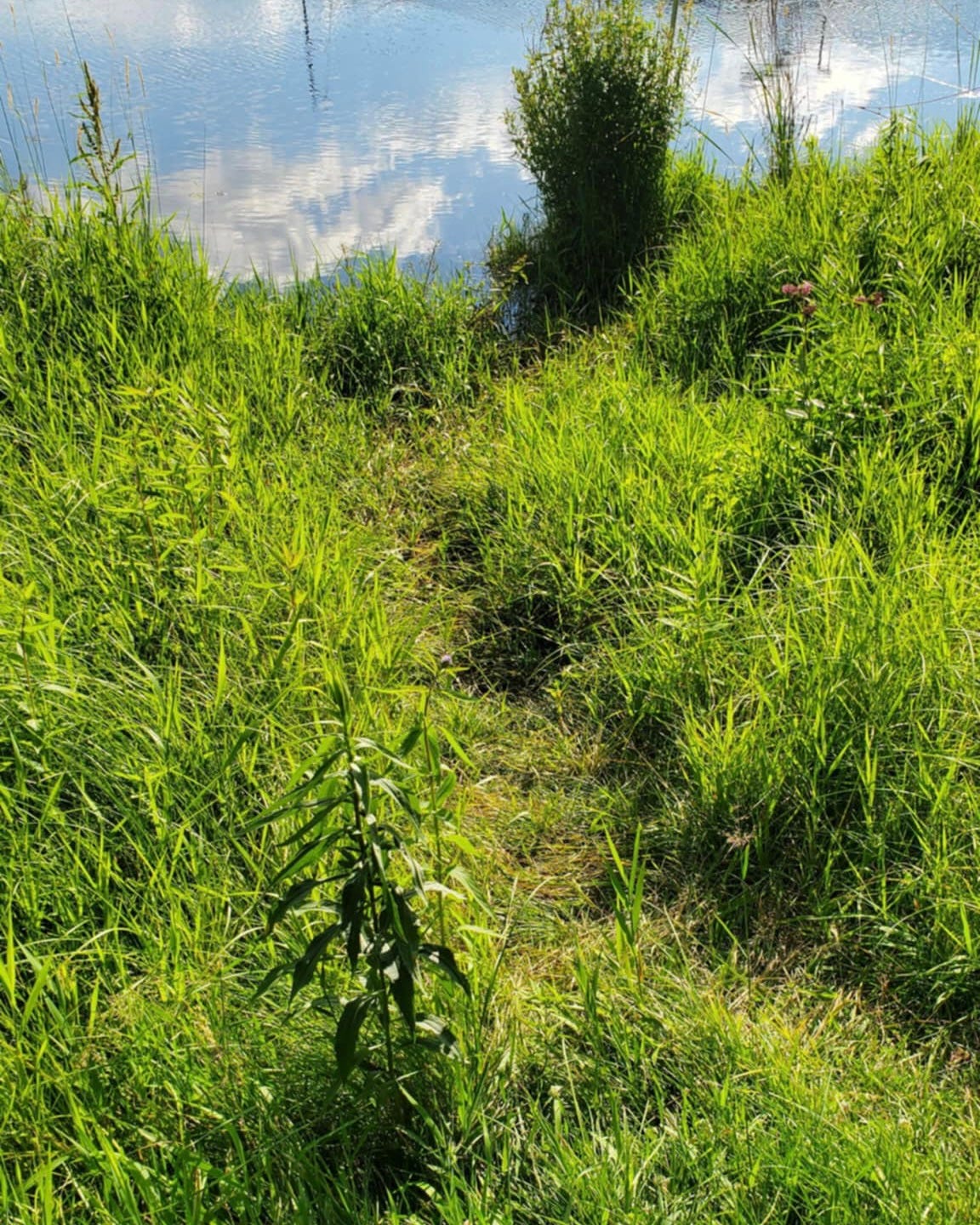Desire Paths
by Susan Hinckley
A desire path is no more than the trace of a decision—less than that, an impulse—to find a new way to join what we know with what we have yet to discover.
—David Farrier
There’s a lot to be said for just doing things the way you want to do them.
On my walk the other day I came across a desire path.1 I noticed it mostly because I hadn’t thought about that phrase desire path for a long time, and as my brain registered the shortcut I remembered those words with satisfaction. I’m not sure when I first heard that description, but I liked it immediately. As a person who’s spent my life insisting no one gets to tell me what to do, I take satisfaction in doing even the most mundane things the way I do because it’s the way I want to do them. It’s kind of a personality flaw, really—sometimes I’m just insisting I know a better way when I absolutely do not. In many cases my way is probably not the best way, but I do it that way anyway. I guess it’s the principle of the thing. I prefer to travel my life via a route that feels like I chose—if not actually created—it.
I don’t belong to a church that respects desire paths though; in fact, quite the opposite. I belong to the church of the covenant path.
He marked the path and led the way, and ev’ry point defines…
We’ve probably all sung this hymn line a thousand times, suggesting that Jesus already showed us exactly where and how to walk, and we’re required to follow Him exactly, if we want to get where we’re supposed to be going. It’s not an overstatement to say that Latter-day Saints insist there’s one way to heaven, and we give a collective side-eye to anyone we see cutting across the grass. In fact, we dismiss whole denominations of those we perceive to be short-cutters: anyone who leans too enthusiastically on grace, for instance, or who thinks they’re “praying” when they’re reciting, or whose prayers don’t look anything like we’re convinced prayers must look. Anyone who picks love over obedience or mercy over justice in that age-old argument. Anyone who sings a song we don’t hear as sacred. Anyone who ignores our covenant path to make their own way through this life.
Our church insists that Jesus staked out the sidewalk, and our leaders have been pouring concrete ever since. That concrete is meant to end the debate.
We call this ongoing restoration. But what about ongoing creation? I mean like the difference between making America great again, and making America great. Who wants to be restored to any “greatness” that wasn’t ever that great for a lot of people? Great as defined by one specific bunch of white men in _____ (pick your date and place)?
I want the kind of greatness we’ve never seen yet, a kind that asks us to be more than we’ve known how to be, to do things differently than we’ve ever done them. Greatness that is for all of us here now, but greatness that also looks for better ways forward.
I want restoration that meets this moment by creating a church more expansive than anything we have yet come up with.
And if we’re talking about church, are we restoring the one that originally sidelined women? How about the one that conducted the crusades? I’m betting every iteration of Christianity has claimed to follow divine guidance. Our church describes it as restoring the one Jesus Himself started, but…did he? I don’t remember Jesus doing most of the things we insist are essential now.
I want restoration that meets this moment by creating a church more expansive than anything we have yet come up with. Restoration that weaves our billions of disparate human paths together into such a wide and willing net, it’s capable of gathering any- and everyone walking this planet, no matter how or where it finds us.
Both those visions of restoration require ongoing creation, a nimble way of moving and willingness to walk in any new direction the present moment may point. Being ready to ignore the old sidewalk in favor of a better way, even if we’re the first to walk it, feels obvious to me. No one’s ever lived in this exact world before. Why would we insist old ways are the best—even only—way to go?
Here’s the thing about desire paths, which is why I love them: they very often ignore a path that’s been laid out by someone else in favor of a different route to the same destination. Desire paths opt for the grass even though some transportation or landscape designer has insisted in concrete that the sidewalk is the correct way to go. My favorite description says this:
“Where the designed way is often straight and rectilinear, the desire path bends and flows. It offers grace rather than instruction.
“Paved roads show us where we ought to go, but desire paths are made when we step off the road and let our hearts decide the way. They seek out the most direct connection between where we are and where we wish to be. Worn by the pressure of passing feet, they’re declarations of a kind: there is another way.”2
No matter how specific a path the church insists we walk, when I look at the way Jesus walked through the world, I see more desire-path than covenant-path. Dust, not concrete.
I see him stop and talk to whomever he wants, whether or not the people with him think that’s a good idea. I see him lag behind when he feels like it, even if it’s going to get him in trouble with his parents. I see him separate himself from the crowd when he needs a little peace and quiet, rest and rejuvenation. “Come, follow me,” he says, but he doesn’t give us a lot of specific directions on how to do it. He doesn’t say, “First do this, then do this, then do this, and it’ll take you straight back to God!”
There’s no list of boxes to tick. It’s more like gesturing toward something very big, so big and so find-able we won’t be able to miss it if we’ll just keep walking His direction.
Grace rather than instruction.
To me, marking the path and leading the way Jesus-style looks more like stopping to have a conversation with one person or healing another, asking some questions or telling a few stories, with an expectation that listeners can draw their own conclusions. Why do you think that is?
Why do you think we’re left to figure out for ourselves the best way to get where Jesus wants us to go? Why did his footprints mark a path through dust?
I think it’s because if there is anything humans might call a covenant path, God knew it must be, first and foremost, a desire path. We’d have to want to find our way, but also be willing to strike out on our own to do it. Because walking through our very individual lives, every one of us will surely encounter many places where the sidewalk everyone else is on isn’t getting us exactly where we need to go. Sidewalks are straightforward, but life-walks are much less so. Sometimes we have no choice but to march right off the end of our map.
People who plan public spaces know that desire paths will inevitably emerge, and often show something that works better for the people using the space than the original plan that was provided by someone else does. Users eschew the designated path in favor of forging their own way for a variety of reasons. Sometimes it’s time or efficiency. Sometimes it’s because the experience is better. Sometimes there’s something off the path that beckons for a closer look. And sometimes it’s because, like me, they resist being told what to do. A desire path says, “I’ll go where you want me to go … but let me get there my own way.”
When I see a desire path, I see a tangible manifestation in the world of the principle, “Yes, and—”
Yes, I can go that way, and I can also go this way.
For instance, Jesus showing me an example of how to pray doesn’t mean I can’t also go in search of God by what I call vespering—walking my meditative laps under the stars. I pray to the whole sky on those walks, because I discern more answers in a dark expanse than I’ve ever received from my bedroom ceiling. Both kinds of prayers are reaching for the same thing, but I prefer to talk to God with my feet and words at once.
Research suggests 15 journeys are all that’s required to introduce a new path through an established environment. I know that 15 nights of walking under the stars shook me loose from my own prayer life and put me on a path that could really get me somewhere. Similarly, 15 people following someone’s footsteps across the grass rather than taking the sidewalk will change the landscape. New ways can become legitimized simply because people choose them.
What could a church (or any) institution learn from observing members’ desire paths? Everything. If there’s anywhere you ought to be able to walk a personal path rather than a designated one, it’s through your own spiritual life. Before it can have any kind of real transformative effect on the people walking it, surely any covenant path must become a desire one.
What might desire paths look like for members of our church? Here are a few ideas:
Find a lot of meaning in your garments? Wear them.
Wear them however and whenever it feels right to you. Feel like a cross represents ideas that are spiritually meaningful to you? Find one you love and feel good every time you have it on.
Reading scriptures filling your cup? Do it.
Feel like you need a little something more? There are so many great writers and thinkers putting books and podcasts into the world. For the first time in history, we have the whole expanse of human thought at our fingertips 24/7! Why would we limit ourselves?
Getting what you want from your prayer life? Keep it up.
Want to switch the emphasis from communication to communion? Create new ways of expressing what’s on your heart. Or maybe just “be” with a little more intention sometimes—let God know when you’re available.

Who knows where each of our desire paths will take us? Who could know? The important part of a phrase like “ongoing-anything” is the ongoing part. Creation isn’t a one-and-done project, it’s an orientation to life and everything in it. Cutting across grass generally spits you back out on the sidewalk eventually, if that sidewalk is going the way you are. Evolution never stops, progression is eternal. It is in any universe I want to live in, anyway, and I do have all the say in how I perceive this great whole and my place within it.
We’re forever choosing where to go and how we want to get there, scanning the path ahead for the next right place for our spiritual foot to fall. Institutions will always lay concrete, but people will still choose dusty paths. Changing direction can be as easy as changing your mind. So go ahead, let your desire mark your path. Let your feet lead your way. The destination is so big, you won’t miss it no matter how you choose to walk. Just keep going.
Susan Hinckley

A desire path is an unplanned small trail formed by human or animal traffic.
David Farrier, Professor of literature and the environment, University of Edinburgh, Emergence Magazine
Thanks for supporting ALSSI! Your paid subscription helps us keep the podcast ad-free. Have something to say? Join the conversation! Send us a voicemail, start a chat thread in our subscriber chat group … or write a piece for a future Say More.







So beautiful. Thank you for this - it is the perfect morning devotional for me today and puts into words how I’ve been feeling for a long time. We are all finding our way to a huge destination that has room for all.
I LOVE this so much. Thank you for yet another inspiring, soul-feeding post ❤️